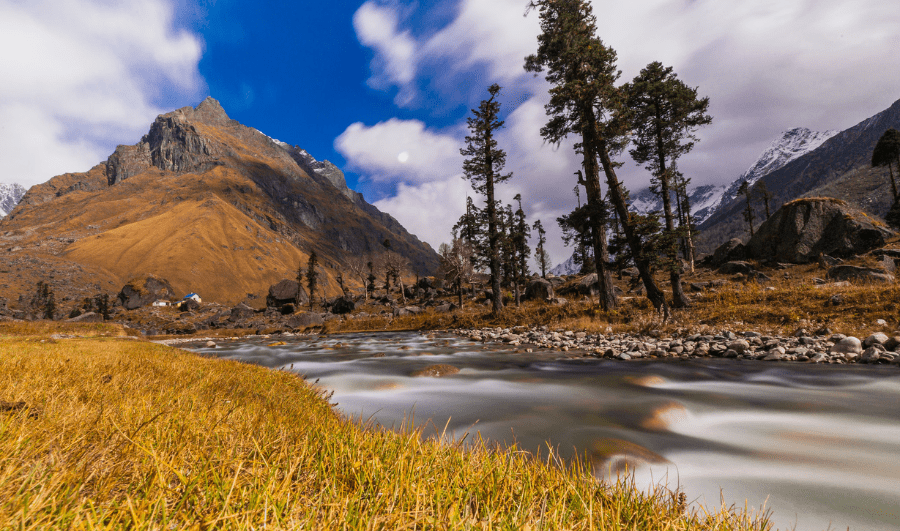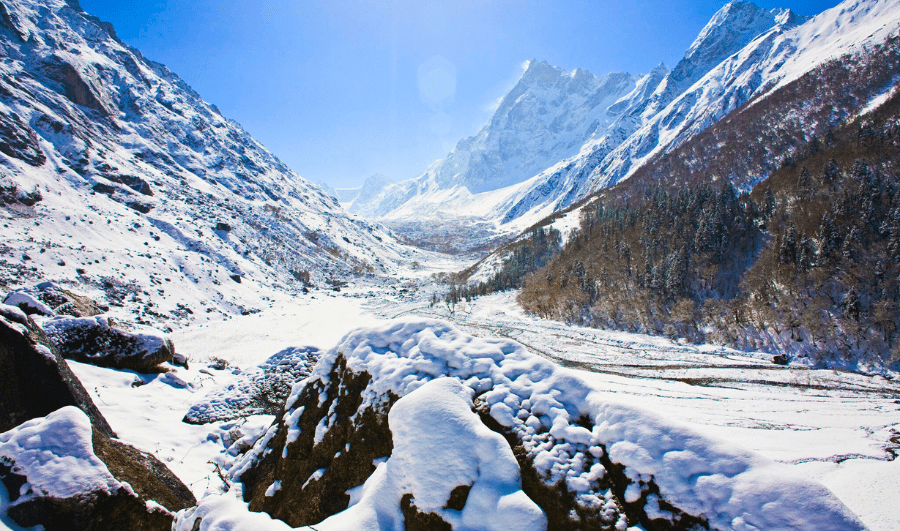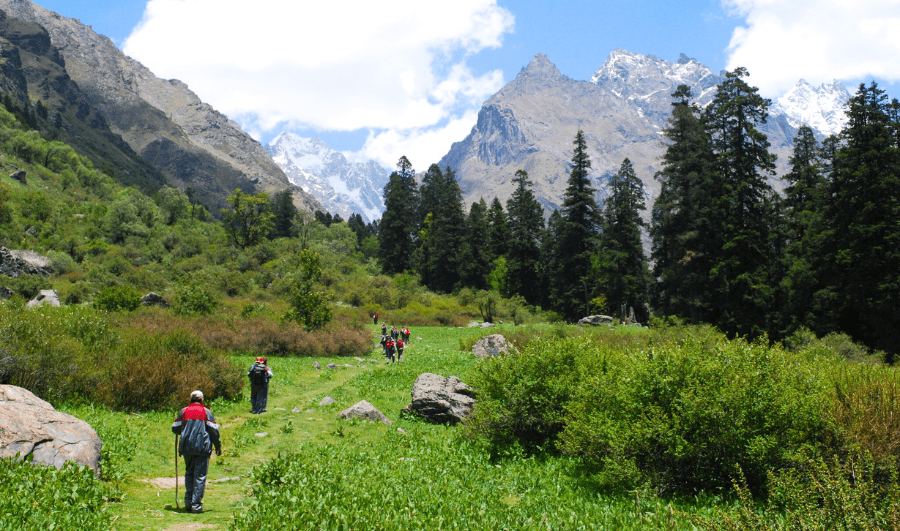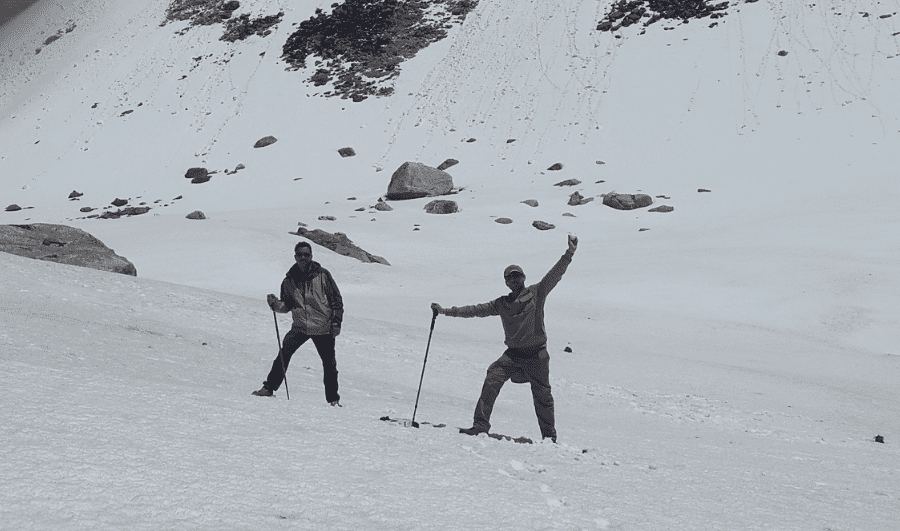The Har Ki Dun Valley also called Ranwai Ghati, locally known as Parvat Ghati – At an altitude of 11,600-12,000fts.
Har Ki Dun Trek is located in the Garhwal Himalayas of Uttarakhand, this trek offers a perfect blend of natural, historical significance and adventure. Starting from the village of Sankri, at an elevation of 1,950 meters (6,398 feet), this trek passes through thick forests of pine trees, oak trees, and rhododendrons. You will also cross fresh rivers and get to old hamlets like Taluka, Someshwar Temple, and Osla that appear to have stopped in time.
While following the trail along Supin River imagine walking along the Supin River, winding through forests. The gentle sound of water soothes you. Crossing wooden bridges and terraced fields, the path gradually leads to the captivating Har Ki Dun Valley. The valley lies at an altitude of 3,566 meters (11,696 feet) above sea level; it covers a distance of around 47 kilometers (29 miles) for a trip back and forth on foot and is enclosed by Kala Nag, Swargarohini, and Har ki Dun mountains offering panoramic views with peaceful alpine pastures. One of the trek’s highlights is camping under a starlit sky in the tranquil Himalayas. The valley teems with flora and fauna, and lucky trekkers might spot rare birds and animals. Engage with the local villagers and hear stories passed down through generations, offering a glimpse into their unique way of life.
The best package for the Har ki Dun trek is one of the Best Summer Treks in the lap of the Himalayas. The ideal time for doing the Har Ki Dun trek is between March-June and September-November. These months are usually pleasant with a lot of vibrancy on the trail. Avoid monsoon season (July-August) due to a heavy downpour that makes the route slippery, and winter months (December-March) because snowfall may see this trek become difficult and inaccessible. Snow begins in November, but beyond that point, it really comes down hard leading to several feet of accumulation. Unfortunately, this heavy snow obstructs the trail to campsites beyond Kalkathiyadhar, making it virtually impossible to complete the trek during this period.
One of the advantages of doing Har ki Dun in summer is that it is a long 10 km walk each day hence can be completed easily in summer without worrying about getting dark in the evening hour. Doing har ki dun trek during spring and summer give you beautiful nature, and nice weather as well as learning other culture’s experience. Blooming flowers, lush greenery, snow-covered peaks, rivers flowing faster than their normal flow rate, and clear skies all over make it look beautiful.The moderate climate during the day and cool nights ensure a comfortable trekking experience, while the approach to the monsoon season adds a sense of urgency to complete the trek before the rains set in.
The Har Ki Dun trek in autumn and early winter offers a unique and serene experience. The crisp, clear views, vibrant autumn foliage, and the possibility of witnessing the first snowfall make this period special. The cooler temperatures and quieter trails provide a peaceful trekking environment, while the cultural insights and stunning landscapes enhance the overall experience. Proper preparation for cold weather and possible snowfall is essential to fully enjoy this beautiful trek during these months.
- Day time: Between 8 °C and 10 °C
- Night time: Will drop to temperatures between 0 °C and -5 °C
- Chances to witness the first snowfall of the season either at the end of October or in November.
How to Reach Har ki Dun Valley
For Har ki Dun Valley, firstly you have to reach Sankri which is 200+ km far from Dehradun district. Then Sankri to Taluka many jeep/taxi services are available, after Taluka one has to trek to Har Ki Dun Valley via Seema and Kalkatiyadhaar. Important note: It must be suggested to plan and book the Har ki Dun Trek Package provided by many travel operators from pickup to departure in Dehradun.
By Air
Dehradun’s Jolly Grant Airport is the closest airport for reaching Har ki Dun Valley. Jolly Grant Airport is well connected to the other major cities in India.
By Bus
Dehradun is also well connected by road. You can get there by taxi or bus from Delhi, or other nearby cities. Later few early morning buses go to the Sankri from outside the Dehradun Railway Station usually takes 9-10 hours to travel. Dehradun is a smart city cab service that is available in-call but pre-plan and book for a hassle-free journey.
By Train
Dehradun railway station is the closest railway station. Take the overnight train to Dehradun from Delhi:
- Nandadevi Express – Train No.: 12205
- Dehradun Express – Train No.: 12687
Tips for a Hassle-Free Journey
- Plan Ahead: Organize your travel plans in advance, especially during peak trekking seasons.
- Check Conditions: Always check the weather forecast and road conditions before your trip to avoid any disruptions.
- Pre-Book: Booking your transportation and accommodation in advance can help ensure a smooth and stress-free journey.
Difficulty Level of Valley of Flowers Trek
The Har Ki Dun trek is considered moderate because of the lack of multiple exits there is only one way in and out. It’s suitable for both beginners and experienced trekkers, with a gradual ascent and a daily walking distance of about 10-12 kilometers (6-7.5 miles). While it doesn’t require advanced trekking skills, a reasonable level of fitness is necessary for a fulfilling experience. Expectation to hike an average of 10km a day, consistent for 3 days to complete the Har ki Dun Trek Package as per the plan package itinerary. Proper preparation and gear are crucial for safety.
Har Ki Dun Trek Itinerary
Day 1: Dehradun to Sankri
Distance: 210 km (124 miles) by road
Altitude: 1,950 meters (6,398 feet)
Travel Time: 8-10 hours approx.
Begin your journey from Dehradun, traveling through picturesque landscapes to reach Sankri, the starting point of the trek. On the way to Sankri, many breathtaking places of views will cross your path like Mussoorie via Kamty Fall initially, later following the drive to Purelo, the best place in the journey to see sunrise and sunset at an altitude of 1524 meters before Sankri 60 km, and Mori River sites beside tons river around the pine trees all around the way.
Day 2: Sankri to Dharkot Village and Trek to Seema
Distance: 16 km drive to Dharkoat + 4 km trek from Dharkoat to Seema
Altitude: 2,100 meters at Dharkot above Taluka
Travel Time: 1 + ½ hours by drive and 4 hours by trek
Early morning breakfast and 16 km drive from Sankri via Taluka to Dharkoat, then trek through dense forests and charming villages to reach Seema. As you are ascending towards the Seema campsites, experience the enchanting music of the descending flow of the Supin River parallel to the trail you are following at Gangaad 10km ahead from Taluka. Trekking up 14km the Seema campsite will be reached on the right side of Supin river. The state bird of Uttarakhand,” Himalayan Monal” is also found in the area Taluka.
The trail from Taluka to Seema passes through dense forests and across bubbling streams, offering encounters with the region's vibrant flora and fauna. Here, you’ll experience the raw beauty of nature and may even spot some local wildlife like Himalayan birds and langur monkeys.
Day 3: Seema to Bosla
Distance: 10 km trek
Altitude: 2600 meters
Trekking Time: 8 hours approx.
As you move from Seema to Osla, you’ll enter a realm where time stands still. Osla village is situated on the opposite shore of the river, perched at 2,560 meters (8,399 feet), and is known for its ancient wooden houses and unique architecture. Engaging with the locals provides a window into their traditional way of life, where customs and stories are preserved through generations.
Trek to Boslo goes through lush greenery, hanging bridge crossing the Supin River with the mighty snow-covered peaks in the background and across sparkling streams. As per different seasons trail experience varies but everyone in these routes is on the mesmerizing feeling to experience in every crossing of the forest of cashew nuts, walnuts or in the monsoon the Amaranth trees with the orange-red hue and the dusky contrast.
Many years ago, villagers admired a deity and erected a temple in their honor. Presently, they continue to educate about this deity, Duryodhan, within the village. However, this location offers more than just that! Surrounded by stories and customs, the village showcases the ancient Someshwar Temple, which dates back 2000 years and features a unique architectural style. The locals dress in attire that embodies their cultural heritage. Every month, the king makes an appearance for the main poo ceremony. As hikers make their way up from Osla, the steep path increases. Stunning vistas of The Dhauladhar range, paths Borasu Pass, and Baspa Valley as reward waiting there for you.
Day 4: Boslo to Har Ki Dun Valley to Maninda Lake and back to Boslo
Distance: 15-17 km
Altitude: 3,566 meters Hari ki Dun and 13,025ft Maninda Lake
Trekking Time: 8-9 hours
Begin the trek earlier than usual as it is the longest. The trek commences after breakfast. The trek from Bosla to Har Ki Dun Valley is marked by awe-inspiring views of snow-capped peaks and glaciers. Crossing terraced fields and ancient stone paths, you’ll be captivated by the pristine beauty of the valley, where every step unveils a new vista of the majestic Himalayas.
The trail winds through glacier basins, mountain meadows, and pine-lined paths. As you ascend towards the junction of the Supin River and Ruinsara Valley River, anticipate a mix of moderate and steep inclines. Icy patches and snow-covered waterfalls add to the thrill. The Har Ki Dun Valley unveils its enchantment—a fusion of meadows, coniferous forests, frozen streams, and majestic mountains. Swargarohini Hata Peak and Black Peak adorn the skyline—the trail peaks at a challenging 45-degree slope, enveloped in snow. Finally, make your way up through dense forests to the summit of Har Ki Dun, where awe-inspiring views await. Do not overlook Maninda Tal (Morinda Tal), a high-altitude lake encircled by Hatta and Swargarohini peaks.
Spend the day exploring the valley, enjoying panoramic views, and soaking in the natural beauty. After creating unforgettable memories, journey back to the last campsite at Kalkattiyadhar.
Day 5: Bosla to Seema
Distance: 10 km (8.7 miles) trek
Descent Altitude: 2,560 meters (8,399 feet)
Trekking Time: 5-6 hours
Retrace your steps back to Seema, descending through the scenic landscapes. As the day comes to an end, the Har Ki Dun trek turns into a journey back home. You'll retrace your steps through the peaceful Osla village, reliving the moments you spent with the serene villagers and bidding farewell to the stunning landscapes. Rise early at the Kalkattiyadhar campsite to witness a breathtaking sunrise. The morning chill, especially in winter, adds to the enchantment of this experience. The familiar trail back to Seema via Pauni Garaat is an easy, gentle downhill descent. Take your time to soak in the surroundings and explore the village. Be sure to visit the ancient Someshwar temple, adorned with intricate carvings. As night falls, rest at the Seema Guesthouse or campsite, savoring your final moments of mountain life.
Day 6: Seema to Taluka via Dharkoat Village and Drive to Sankri
Distance: 16 km drive to Dharkoat + 4 km trek from Dharkoat to Seema
Altitude: 2,100 meters at Dharkot above Taluka
Travel Time: 1 + ½ hours by drive and 4 hours by trek
Trek back to Taluka and drive to Sankri for the night. In the Morning with breakfast at your get ready to trek the last time from Seema to Dharkoat via dense forests. This is the last day of your camping, feel relaxed and proud to finish this beautiful challenging trek. The stay will be scheduled at Sankri base camp.
Day 7: Departure- Sankri to Dehradun
Distance: 200 km (124 miles) by road
Travel Time: 7-8 hours
It was a long journey but going back would feel more long 200+ km back to Dehradun. Breakfast (Tea, Coffee, and Biscuits provided in the camps) and Lunch will be on the way back as we will leave in the early morning at 8 am. Return to Dehradun, marking the end of your trekking adventure.
Frequently Asked Questions (FAQs)
1. What’s Valley of Flowers Trek Best Time?
If you want to visit the Valley of Flowers trek then you should consider anywhere between June to September. During this time the valley is covered in lush green and vibrant flowers.
2. Is it difficult to trek in the Valley of Flowers Trek?
The valley of flowers is considered as easy to moderate in terms of difficulty. So, if you are a beginner or expert trekker you can easily complete this trek. But you need to be physically fit to enjoy the trek.
3. How long does it take to reach this place from Dehradun?
The distance from Dehradun to the Valley of Flowers is around 300 km. and it takes around 8-10 hours to reach there.
4. How many days does it take to finish this hike?
It will take around 6-7 days to complete the trek. It will include your travel time to reach the location, staying on camping sites, and returning to Dehradun.
5. Does it snow in the Valley of Flowers Trek?
Yes, snowfall begins from December until winter ends. As the Valley of Flowers is situated at an astonishing height of 12,000 feet the valley is covered in snow and makes it difficult to reach there as the trek remains closed in winter.
```



